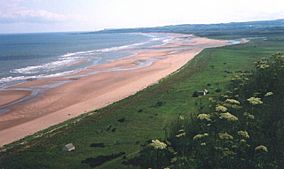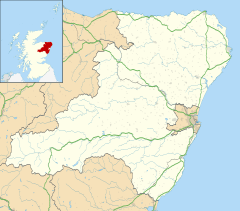St Cyrus National Nature Reserve facts for kids
Quick facts for kids St Cyrus National Nature Reserve |
|
|---|---|
|
IUCN Category II (National Park)
|
|

St Cyrus Beach
|
|
| Location | Aberdeenshire, Scotland |
| Area | 92 ha (230 acres) |
| Established | 1962 |
| Governing body | NatureScot |
| St Cyrus National Nature Reserve | |
St Cyrus National Nature Reserve (NNR) is a special place in Scotland. It is located in Aberdeenshire, right by the North Sea. This reserve is a long, narrow strip of land, about 3.5 kilometers long.
It covers an area of 92 hectares (about 227 acres). Most of the land is low, only a few meters above the sea. Tall cliffs protect the reserve on its western side. The River North Esk forms its southern edge. St Cyrus NNR was created in 1962. It is looked after by an organization called NatureScot.
The cliffs and sand dunes here are very important. They provide a home for many flowering plants and insects. Some of these plants and insects are found here at their most northern point in Britain. The reserve is one of the best places in northeast Scotland for plants. It has over 300 different kinds of plant species.
There is a visitor center at St Cyrus NNR. It is in an old lifeboat station. NatureScot runs the center. It has special facilities for school groups, bird watchers, and plant lovers. The center opened in 1989 and was updated in 2004. Many people visit the center each year. NatureScot has also marked a 1.5-kilometer path called the Tyrie Trail. There are other paths to explore the reserve too.
Contents
Amazing Rocks and Changing Land
The tall cliffs at St Cyrus NNR are very old. They formed about 400 million years ago. These cliffs are mostly made of rocks called andesite and basalt. They used to be sea cliffs. They formed when the sea level rose after the last Ice Age. This happened as the ice melted.
You can see how the sea level has changed over time. Look for the raised beaches at the bottom of the cliffs. The coastline at St Cyrus NNR is always changing. The sand dunes are still growing today. Even the River North Esk has changed its path. Its old channel from before 1879 can still be seen. The river's mouth also moves along the coast over time.
Plants and Animals of St Cyrus
St Cyrus has a warmer climate than other parts of northeast Scotland. This is because of the sea's warming effect. Because of this, many plants here live at their northernmost limit. This means they don't usually grow further north.
Wonderful Wildflowers
Some special plants found here include maiden pink, wild liquorice, and yellow vetch. You can also find the carnivorous Nottingham catchfly. These plants are important for the reserve's insects.
Incredible Insects
With so many wildflowers, St Cyrus NNR is a great place for insects. Many butterflies, moths, and grasshoppers live here. The small blue butterfly is very special. It is a protected species and lives here at its northern limit. Over 200 types of moths have been seen at the reserve. This includes the cinnabar moth, which is also at its most northern point here. The land snail Cepaea nemoralis also lives here at its northern limit.
Birds of the Reserve
St Cyrus NNR is a famous spot for birds. More than 70 different kinds of birds have been recorded here. You might see wading birds like redshank, oystercatcher, common sandpiper, and curlew. The cliffs are home to birds of prey. These include buzzards, kestrels, and peregrine falcons.
The gorse bushes provide nesting places for small birds. Look for whitethroats, stonechats, and yellowhammers. St Cyrus used to have many little and arctic terns nesting. They have not been seen as much in recent years.
Other Animals
You can find several mammals at St Cyrus. These include roe deer, foxes, stoats, and rabbits. Common and grey seals rest on the sand banks near the River North Esk. Sometimes, you might even see dolphins, porpoises, minke whales, and killer whales offshore. The main reptiles and amphibians here are common lizards, common frogs, and common toads.
History of St Cyrus
While there are no old ruins right inside the reserve, it surrounds an old graveyard. This graveyard is called the Nether Kirkyard. It was part of a church called Ecclesgreig, built in 1242. The church is gone, but some old gravestones remain.
Close to the visitor center, there is a cave in the cliffs. Neolithic people used this cave a very long time ago. Bones found in the cave are from a midden. A midden is like an ancient trash heap. People used it between 4,000 and 3,000 BC. The bones were from different animals. Pieces of pottery and an amulet were also found. A castle called the Kaim o' Mathers is just north of the reserve. It was built in the early 15th Century.
A lifeboat station was built here in the 1860s. But the River North Esk changed its path. So, the station was no longer used by the mid-1880s. This building is now the reserve's visitor center.
Protecting the Reserve
St Cyrus National Nature Reserve is a Category II protected area. This means it is a national park or similar protected area. It is also part of a larger area called the St Cyrus and Kinnaber Links Site of Special Scientific Interest (SSSI). This SSSI is 305 hectares, much bigger than the NNR. NatureScot is thinking about making the NNR even bigger. They want to include the foreshore area, which is currently managed by Crown Estate Scotland.




